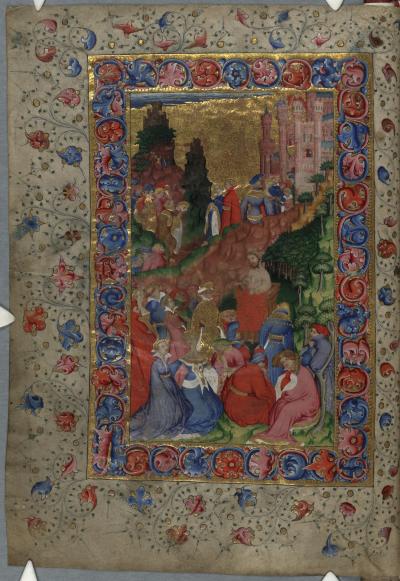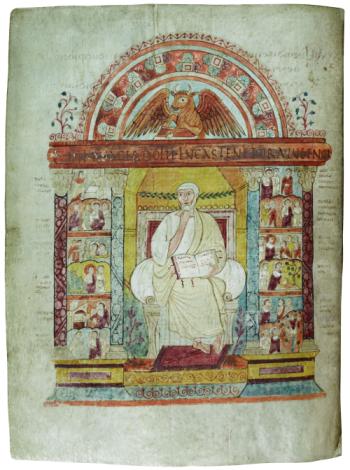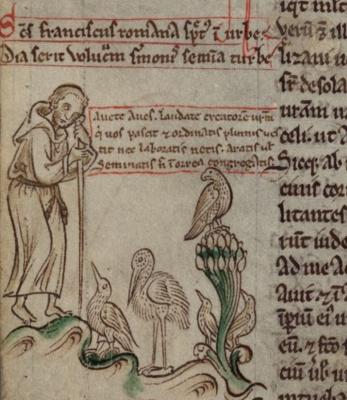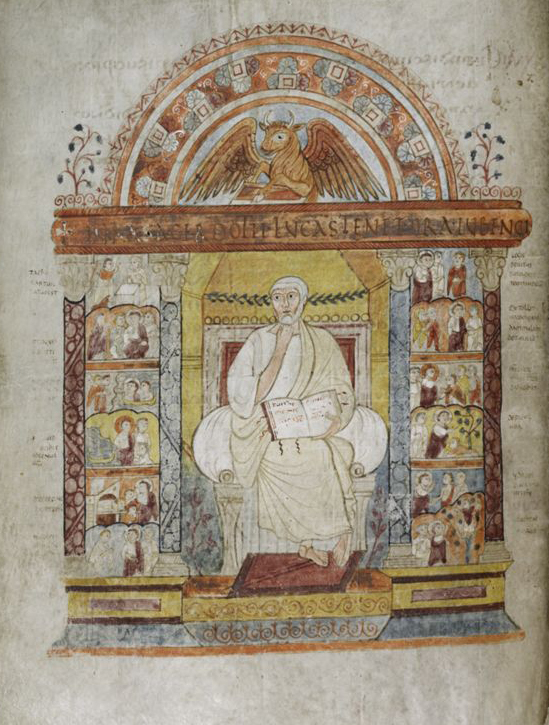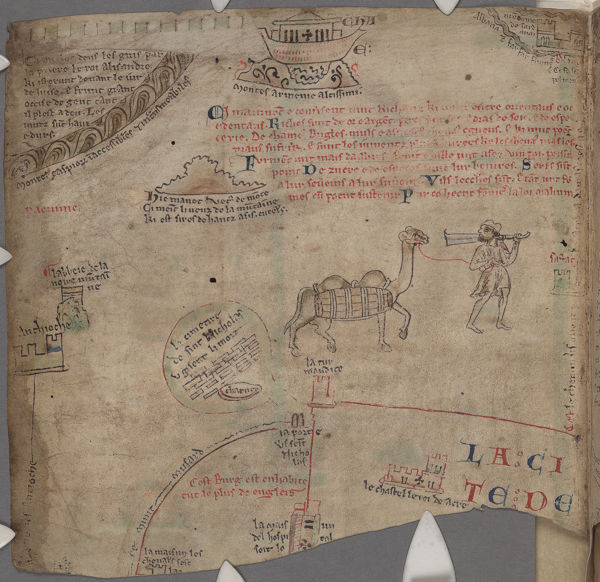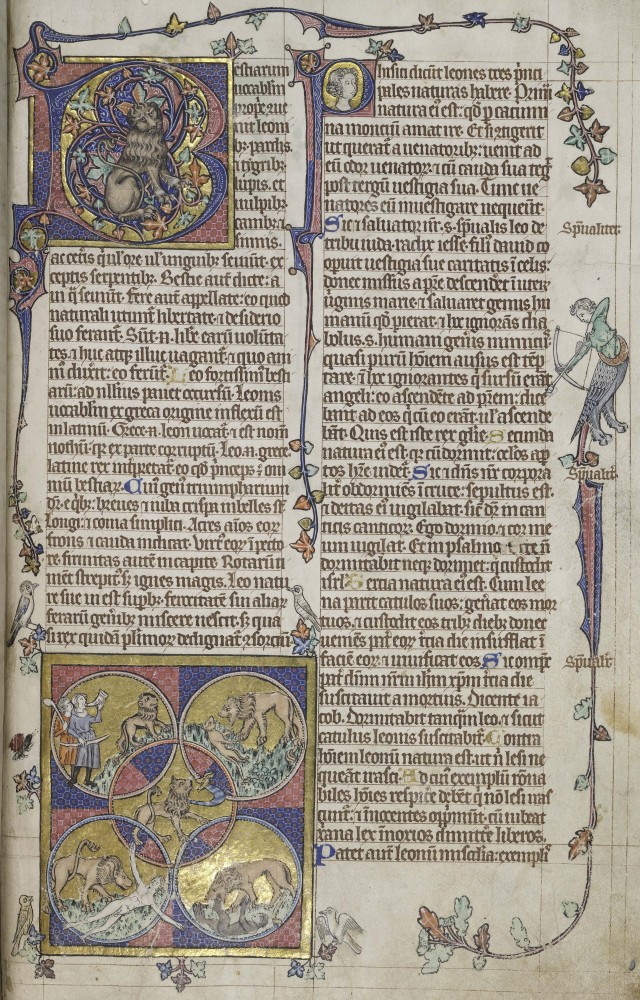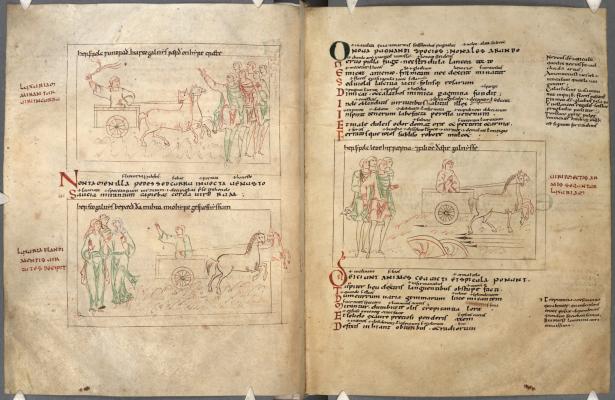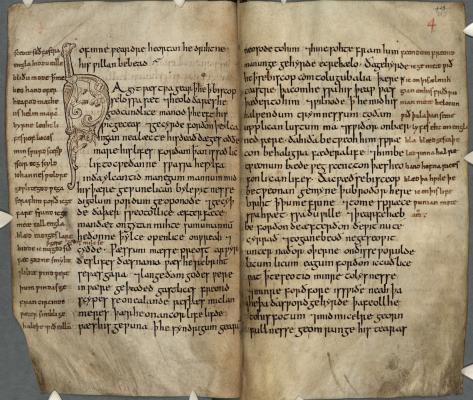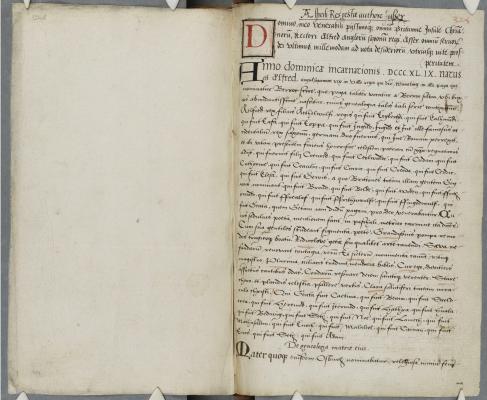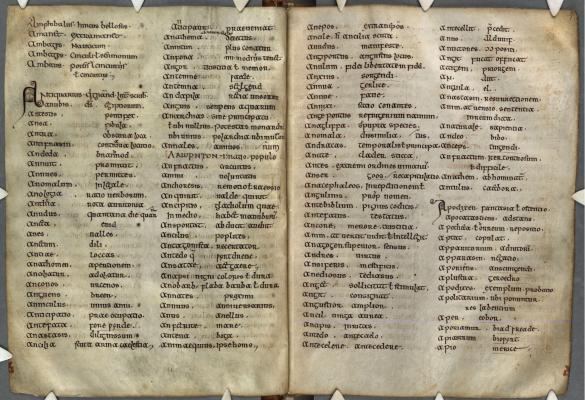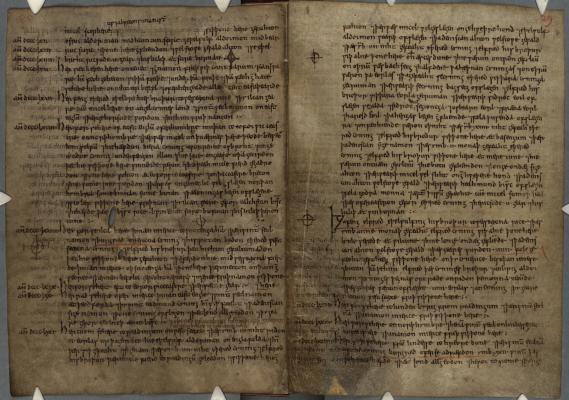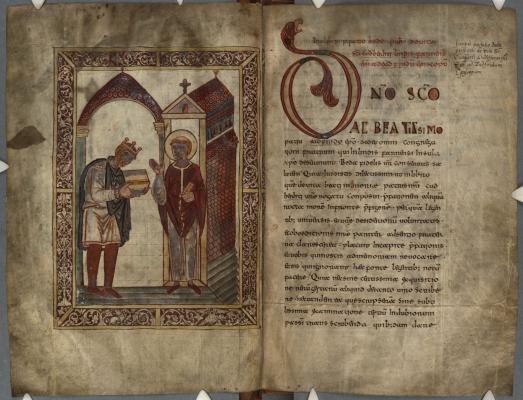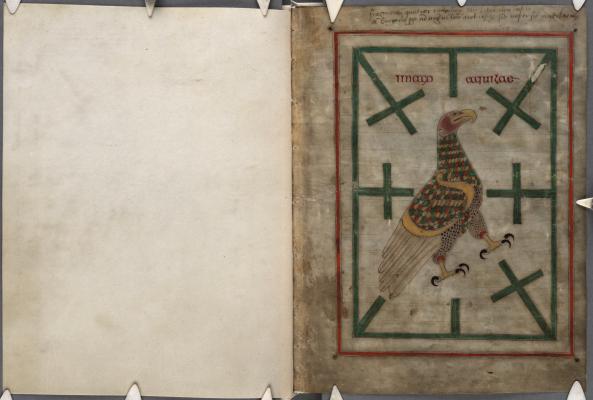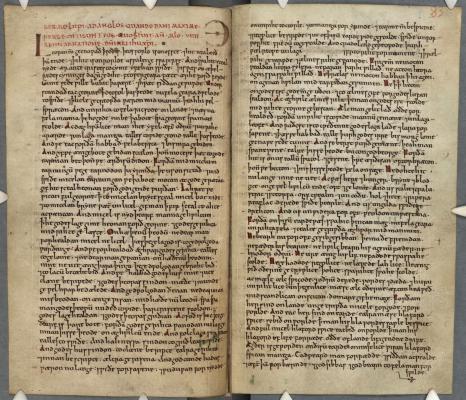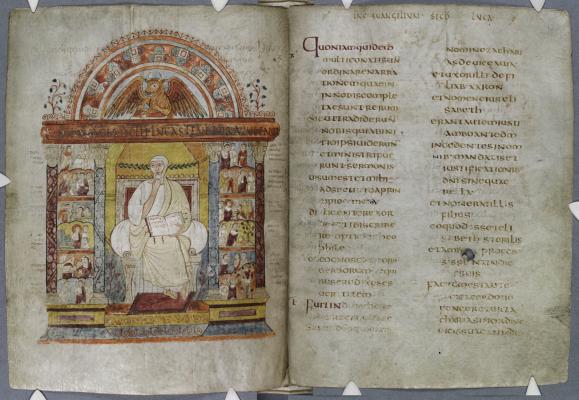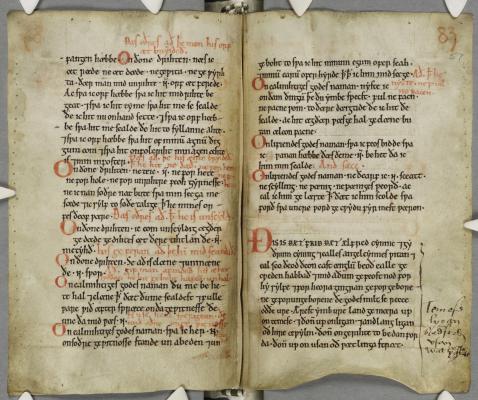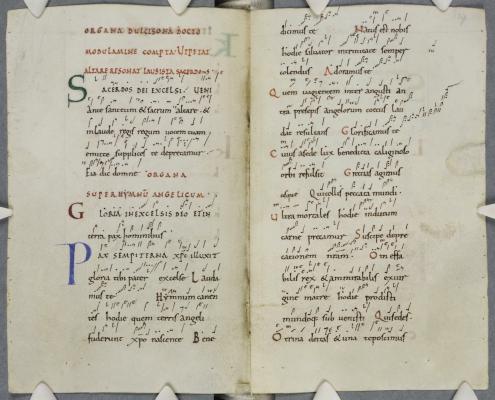Parker on Loan
Chaucer’s Troilus and Criseyde travels to the Bodleian
8 December 2023
Image: Full-page frontispiece with a man speaking from a pulpit to a large audience dressed in red, blue and gold. (CCCC MS 61, f. 1v; made c. 1415–1425)The author Geoffrey Chaucer (c. 1340–1400) has fascinated audiences ever since the Middle Ages. A new exhibition in the Bodleian Libraries’ Weston Library, Chaucer Here and Now, explores the many creative responses to Chaucer and examines how his works have been reworked and reinterpreted over time and around the world.
The Parker Library has contributed to the exhibition with a loan of our copy of Chaucer’s Troilus and Criseyde (available also fully digitised on Parker on the Web: CCCC MS 061). The manuscript was made c. 1415–25, long after the poet's death in 1400. The full-page frontispiece shows that the copy was a luxury edition. In the image Chaucer is shown standing at a wooden pulpit with a scarlet cloth draped over the front. He is reading his poem to a group of seated and standing ladies and gentlemen of the English court. The listeners are intent on the speaker.
The patron of this manuscript is unknown, but it is likely to have been the prominent male figure dressed in a gold-embroidered costume in the centre of the courtly group. On 17 December 1570 the book was given by ‘Mr Cari’ (William Cary(e), a London cloth worker) to Stephen Batman (d. 1584), a chaplain of Archbishop Matthew Parker and an avid book collector. Shortly after the manuscript became incorporated in Parker’s collection.
To see our Chaucer manuscript and all the other exhibits, make a visit to the St Lee Gallery, Weston Library, Oxford from 8 December 2023–28 April 2024. Admission is free of charge.
The Augustine Gospels at Westminster Abbey
06 May 2023
The Augustine Gospels – one of the College’s most precious and historic items – was part of King Charles III’s Coronation service at Westminster Abbey on Saturday 6 May. The 6th-century Gospels are the oldest surviving illustrated Latin Gospels in the world and the oldest non-archaeological artefact of any kind to have survived in England, continuously owned and in use for over 1,400 years. Their fundamental significance to the nation was recognised when the Gospels were inscribed in 2023 on the UNESCO UK Memory of the World Register.
Around 11.20 Dr Philippa Hoskin (who is both the Director of the Parker Library and the Dorothy and Gaylord Donnelley Fellow Librarian) handed the Gospels to the Master of Corpus Christi Cambridge College, Professor Christopher Kelly, behind the altar screen. The Master processed with the Augustine Gospels down the aisle and stood in front of the Right Reverend and Right Honourable Dame Sarah Mullally DBE, Dean of His Majesty’s Chapels Royal, who read Luke 4: 16–21 in English. The book of Gospels was open at the page showing the portrait of St Luke and the beginning of the Gospel of Luke (ff. 129v-130r). After the reading, the Master walked over to King Charles III to show him the Augustine Gospels before taking the Gospels back behind the altar screen as the King began to get ready for the anointing. The manuscript’s 25-minute participation in the coronation came to an end with the Fellow Librarian taking the manuscript back to her custody.
We were delighted at this opportunity both to draw the attention of an international audience to the Parker Library – one of Cambridge’s greatest national heritage treasures – and to our College as a place of learning, education and research. We wish to continue our recent emphasis on access, not only to the College itself through the establishment of the ‘Bridging Course’ (which has transformed our student body), but also through sharing more widely the remarkable resources of the Parker Library On the Web. The Gospels of St Augustine (MS 286) can be viewed online and downloaded in full as a pdf.
Saint Francis of Assisi at the National Gallery, London
06 May - 30 July 2023
It is with great pleasure and joy that the Parker Library offers a medieval manuscript for loan to this first major UK art exhibition exploring Saint Francis of Assisi’s life and legacy from 6 May - 30 July 2023.
Presenting the art and imagery of Saint Francis (1182–1226) from the 13th century to today, this exhibition looks at why this saint is a figure of enormous relevance to our time due to his spiritual radicalism, commitment to the poor, and love of God and nature, as well as his powerful appeals for peace, and openness to dialogue with other religions.
From some of the earliest medieval panels, relics and manuscripts, to modern-day films and a Marvel comic, the exhibition shines a light on how Saint Francis has captured the imagination of artists through the centuries, and how his appeal has transcended generations, continents and different religious traditions.
Our famous copy of Chronica Maiora by Matthew Paris (c. 1200–59), a chronicle of the world and the British history extending to year 1253 (now CCCC MS 16ii), presents a summary of the life of St Francis, and is accompanied with some coloured marginal drawings of him (fols 70v-71r).
More information about this exhibition
The Lindisfarne Gospels at The Laing Art Gallery, Newcastle
20 September - 3 December 2022
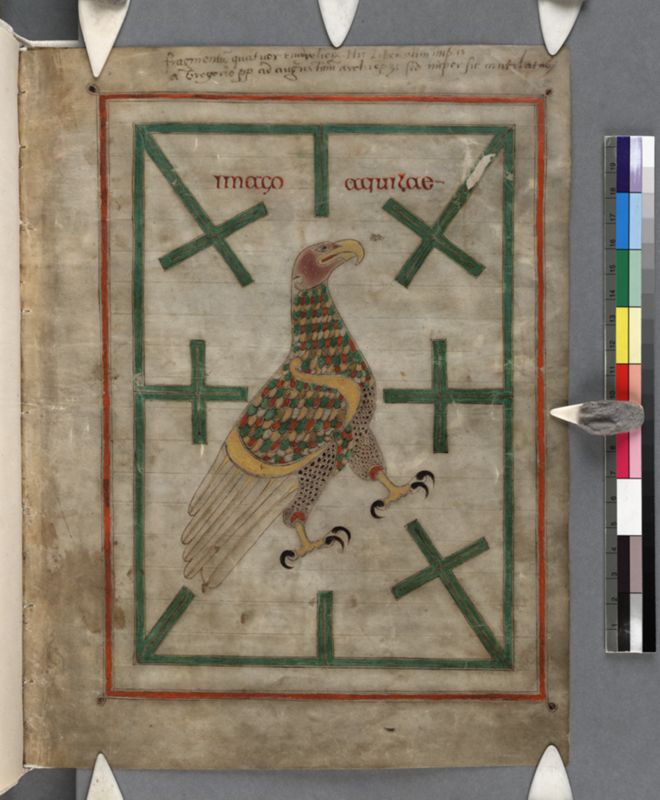 The Lindisfarne Gospels, the most spectacular manuscript to survive from Anglo-Saxon England, will be on display at the Laing Art Gallery from 17 September to 3 December 2022, on loan from the British Library.
The Lindisfarne Gospels, the most spectacular manuscript to survive from Anglo-Saxon England, will be on display at the Laing Art Gallery from 17 September to 3 December 2022, on loan from the British Library.
The Lindisfarne Gospels will feature in a contemporary exhibition about its meaning in the world today and its relationship with themes of personal, regional and national identity.
Created on the Holy Island of Lindisfarne, the book represents the golden age of design and craftsmanship in Northumbria and has survived in almost perfect condition for over one thousand years.
The exhibition will begin with an immersive digital experience and include a stunning selection of early medieval treasures brought together from across Britain, representing both personal and collective religious experiences in the 8th century. A selection of paintings, drawings and photographs will further explore how art and spirituality have developed in the centuries since the Lindisfarne Gospels were created. One of the most significant manuscripts exhibited is loaned by The Parker Library: our beloved Northumbrian Gospels (CCCC MS 197b), believed also to have been made on Lindisfarne, and at around the same date, making our loan amongst its most significant relatives, in addition to its own celebrated claim as amongst the earliest decorated manuscript in the British Isles. A wealth of supplementary information exploring this fantastic treasure - including a fully digitised facsimile and a rich, comprehensive bibliography - is available online through our Parker on the Web resource here.
Alongside the Laing exhibition, there will be a supporting exhibition at neighbouring Newcastle City Library and venues across the North East will host complementary events in an Inspired By programme. The plan to display the Gospels in Newcastle was co-ordinated by the North East Culture Partnership and the British Library.
You can learn about the Lindisfarne Gospels by exploring the digitised collection items on the British Library website here. Zoom in on the book’s intricate illuminations, or see if you can decipher the Old English gloss added between the lines of the main Latin text by a priest named Aldred – the earliest rendering of the Gospels in the English language.
For more information on this exhibition, please click here.
Die Normannen / The Normans at The Reiss-Engelhorne Museum, Mannheim, Germany
18 September 2022 - 26 February 2023
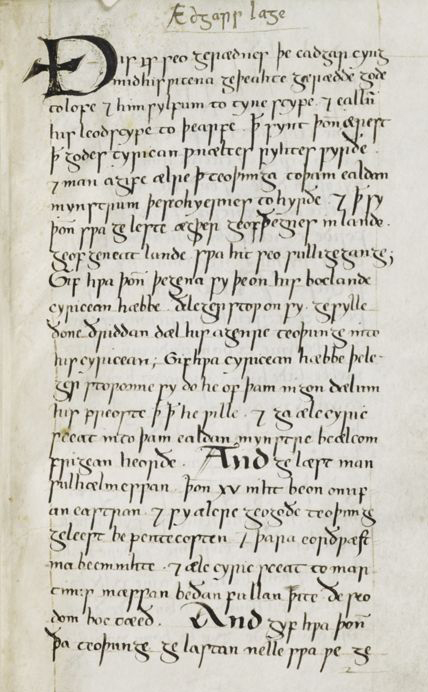 The history of the Normans continues to astonish and surprise to the present day: starting out as highly mobile warriors, mercenaries or minor aristocracy, Normans became powerful princes and rulers who left their traces all over Europe and beyond. Their history is a story of interconnectedness, which influenced in a long-lasting way the cultural and political development of Europe and the Mediterranean.
The history of the Normans continues to astonish and surprise to the present day: starting out as highly mobile warriors, mercenaries or minor aristocracy, Normans became powerful princes and rulers who left their traces all over Europe and beyond. Their history is a story of interconnectedness, which influenced in a long-lasting way the cultural and political development of Europe and the Mediterranean.
For the first time in such a comprehensive fashion, the Reiss-Engelhorn-Museen and their partners will dedicate an exciting exhibition project under German-French aegis to the “men from the North”. In a presentation with around 300 outstanding exhibition-pieces from more than 10 countries, the exhibition tells a multifaceted story and ties together different and highly fascinating threads of a history spanning the eighth to thirteenth centuries.
Prominent exhibits include two manuscripts loaned by The Parker Library: CCCC MS 373 (here), is the unique copy of an anonymous chronicle, closely modeled on Ekkehard of Aura's Imperial Chronicle, a history of the Franks (early twelfth century), but also incorporating material from the World Chronicle (ending c.1111) of Sigebert of Gembloux (c. 1029/9-1112), continued down to 1114, shortly after which date this copy was produced in Germany.
CCCC MS 276 (here) was copied c. 1100 at St. ugustine's Abbey, Canterbury, and contains the Historia Normannorum of Dudo of Saint-Quentin (c. 960-1026). As such, it witnesses the cultural influences at work at one of the most important centres of scribal culre and book production in the first generations after the Norman Conquest.
Such precious works of art encounter other treasures, weapons and manuscripts coming from North-, East- and West-Europe as well as one of the most important the Mediterranean. These exhibits are complemented by the latest digital reconstructions which provide innovative ways of displaying and transferring knowledge.
Discover the secrets of the Normans’ success, as well as when and why these techniques failed them. Embark on an adventurous journey from Scandinavia across Europe to the Black Sea and the Mediterranean.
The exhibition is developed and presented together with the “Réunion des Musées Metropolitains” in Rouen and connected to a co-project realised by the Musée de Normandie in Caen.
For more information on this exhibition, please click here.
Making Money in the Early Middle Ages at The Fitzwilliam Museum, Cambridge
14 January - 20 February 2022
 - Copy 1.jpg) Drawing on the Fitzwilliam Museum’s world-leading collection of early medieval currency, this exhibition explores the changing imagery and material of early medieval coins, exploring their meaning. It reveals how different societies and governments operated under changing and often challenging circumstances.
Drawing on the Fitzwilliam Museum’s world-leading collection of early medieval currency, this exhibition explores the changing imagery and material of early medieval coins, exploring their meaning. It reveals how different societies and governments operated under changing and often challenging circumstances.
This fascinating exhibition features two unique Anglo-Saxon manuscripts, both Parker manuscripts, which illustrate the interconnections of currency, images and power in this period. The first is CCCC MS 183, our celebrated copy of the Lives of the Venerable Bede, commissioned by Æthelstan, King of the English (924/5-39), commissioned specially for presentation to the community of St Cuthbert, then at Chester-le-Street, in Co. Durham, having fled Lindisfarne to escape Viking attacks, but later settled at Durham. The second is CCCC MS 383, a late eleventh-century manuscript containing a very early version of the Anglo-Saxon law codes.
The exhibition is made possible through the generous support of the Arts & Humanities Research Council for the project “Foundations of Gold and Silver”.
For more information about this exhibition, please click here.
Chroniclers of History at St Albans Museum & Gallery
30 July - 31 October 2021
.jpg) During the medieval period the monastery of St Albans had a national reputation for the quality of its chroniclers. From the twelfth until the fifteenth century a series of monks produced histories of the events affecting the church (and in particular the Abbey of St Albans and its holdings) and state.
During the medieval period the monastery of St Albans had a national reputation for the quality of its chroniclers. From the twelfth until the fifteenth century a series of monks produced histories of the events affecting the church (and in particular the Abbey of St Albans and its holdings) and state.
As one of the greatest monasteries in medieval England, and with a geographical position that placed it close to the events of the royal court and those who frequented it, the Abbey was able to make good use of its contacts to often provide first hand accounts of the activities of the king, his dukes and their followers as well as access to important documents to corroborate or source material from.
No other monastery produced histories for as long as St Albans, and many of its chroniclers, who included Roger of Wendover, Matthew Paris, William Rishanger, Thomas Walsingham and John of Wheathampstead, came to be celebrated as amongst the finest in the country.
The Parker Library is pleased and proud to be contributing three medieval manuscript loans to this fine exhibition, including a wonderful late-twelfth century pandect bible from medieval St Albans (now CCCC MS 48), and of course Matthew Paris' beloved portrait of the first English elephant, preserved in CCCC MS 16i.
For more information about this exhibition, please click here.
Lives and Legacies Exhibition at St Albans Cathedral
19 July - 3 September 2021
.jpg) From Monday 19 July, uncover the fascinating stories of the individuals who visited and invested in St Albans Abbey over six centuries.
From Monday 19 July, uncover the fascinating stories of the individuals who visited and invested in St Albans Abbey over six centuries.
The Lives and Legacies Exhibition explores the rich tradition of gift-giving and benefaction evident in the Chronicle and Register of the Benefactors of the Monastery (now CCCC MS 7). This stunning 15th century manuscript, which we have loaned for the duration of this exhibition, records the gifts given to the Abbey by men and women of both high and low status. Marvel at the colourful, illuminated portraits in its pages, and learn about the monks, royalty, townspeople, and pilgrims who lived and worshipped in this place.
The Lives and Legacies exhibition is part of a city wide celebration of the manuscripts of St Albans Abbey. If you enjoyed our exhibition, visit Chroniclers of History at St Albans Museum & Gallery - also featuring Parker Library loans - to find out more.
For more information about this exhibition, please click here.
Thomas Becket: Murder and the Making of a Saint at The British Museum
20 May - 22 August 2021
.jpg) Discover the murder that shook the Middle Ages in this dramatic exhibition about the life, death and legacy of Thomas Becket.
Discover the murder that shook the Middle Ages in this dramatic exhibition about the life, death and legacy of Thomas Becket.
On 29 December 1170, Becket was assassinated in Canterbury Cathedral by four knights with close ties to King Henry II, an act that left Medieval Europe reeling. Becket was one of the most powerful figures of his time, serving as royal chancellor and later as Archbishop of Canterbury. Initially a close friend of Henry, the two men became engaged in a bitter dispute that culminated in his violent and public death – an event that sent shock waves across Europe and caused an immense political fallout.
Marking the 850th anniversary of his brutal murder, this special exhibition presents Becket's tumultuous journey from a merchant's son to an archbishop, and from a revered saint in death to a 'traitor' in the eyes of Henry VIII more than 350 years later.
Get up close to the man, the murder and the legend through an incredible array of objects associated with Becket; from illuminated manuscripts, some of which include eyewitness accounts of the murder, to jewellery and sacred reliquaries. The exhibition features a trio of Parker manuscripts, MS 26, MS 46 and MS 411, which number amongst the most significant surviving books related to Becket, alongside objects from the British Museum collection, and important loans from major collections across the UK and Europe, including an entire medieval stained glass window on loan for the first time from Canterbury Cathedral.
For more information about this exhibition, please click here; to book tickets, click here; for the exhibition's catalogue, click here.
The Human Touch: Making Art, Leaving Traces at The Fitzwillliam Museum, Cambridge
18 May - 1 August 2021
.jpg) Touch is our first sense. Through touch we make art, stake a claim to what we own and those we love, express our faith, our belief, our anger. Touch is how we leave our mark and find our place in the world; touch is how we connect.
Touch is our first sense. Through touch we make art, stake a claim to what we own and those we love, express our faith, our belief, our anger. Touch is how we leave our mark and find our place in the world; touch is how we connect.
The events of 2020 have made us newly alive to both the value and the dangers of touch, and many of the one hundred and fifty or so objects in the show and its accompanying catalogue have become doubly powerful in the context of the pandemic. This exploration of our most fundamental sense is urgent, timely and resonant.
Drawing on works of art spanning four thousand years and from across the globe, this exhibition explores the fundamental role of touch in human experience, and offers new ways of looking. The curators explore anatomy and skin; the relationship between the brain, hand, and creativity; touch, desire and possession; ideological touch; reverence and iconoclasm. A final section collects a range of reflections, historic and contemporary, on touch.
Objects range from ancient Egyptian limestone sculpture to medieval manuscripts and panel paintings, from devotional and spiritual objects to love tokens and faith rings from all over the world. This exhibition features our own CCCC MS 298, a unique sixteenth-century copy of the Life of St Thomas Becket in Middle English verse written in 1497 by Laurence Wade; it appears alongside drawings, paintings, prints and sculptures by Raphael, Michelangelo, Rembrandt, Carracci, Hogarth, Turner, Rodin, Degas, and Kollwitz in addition to work by contemporary artists Judy Chicago, Frank Auerbach, Richard Long, the Chapman Brothers, Richard Rawlins, Donald Rodney and others.
For more information about this exhibition, please click here or here; to book tickets, click here.
Feast and Fast: The Art of Food in Europe (1500-1800) at The Fitzwilliam Museum, Cambridge
26 November 2019 - 26 April 2020
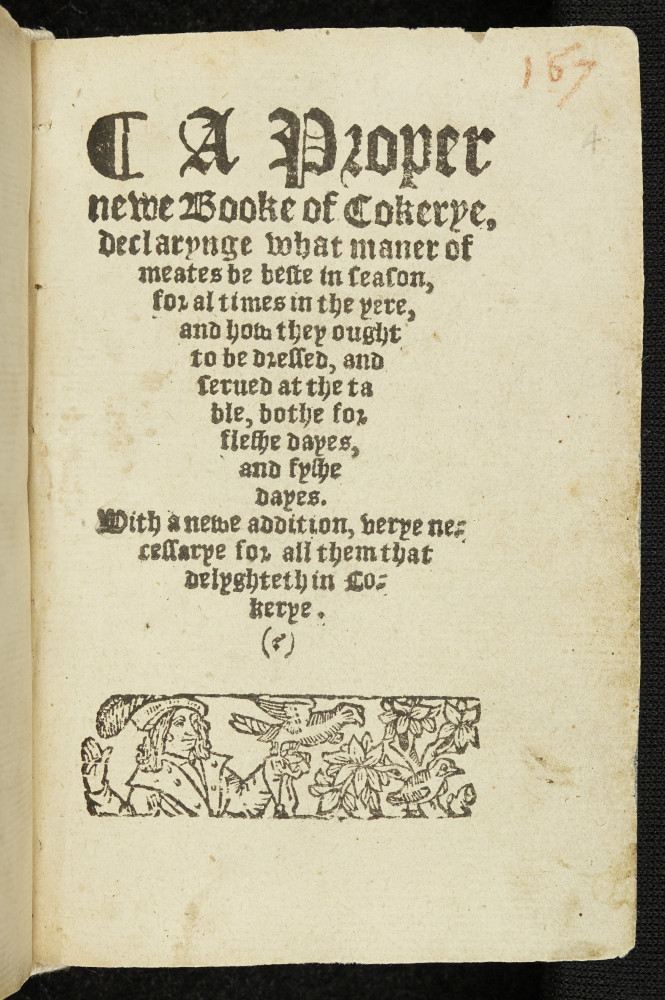 Food defines us as individuals, communities, and nations: we are what we eat and, equally, what we don’t eat. When, where, why, how and with whom we eat are crucial to our identity. The exhibition Feast & Fast presents novel approaches to understanding the history and culture of food and eating.
Food defines us as individuals, communities, and nations: we are what we eat and, equally, what we don’t eat. When, where, why, how and with whom we eat are crucial to our identity. The exhibition Feast & Fast presents novel approaches to understanding the history and culture of food and eating.
This research‐led multi-sensory exhibition will showcase hidden and newly‐conserved treasures from the Fitzwilliam and other collections, and features four spectacular historical reconstructions with food at their centre, including a Jacobean sugar banquet, a European feasting table and a Georgian confectioner’s workshop. It will tease out many contemporary and controversial issues – such as the origins of food and food security, over consumption in times of austerity, and our relationship with animals and nature – thereby linking the past with our present, and encouraging visitors to question and rethink our relationship with food.
To complement Feast & Fast, a flamboyant 4-metre tall pineapple installation created by Bompas and Parr - experts in multi-sensory experience design - was displayed on the Museum’s front lawn for the duration of the exhibition and illuminated at night.
For more information about this exhibition, please click here; to view a video about the exhibition, click here; for the exhibition's catalogue, click here.
Galicia, a Story in the world at The Museo Centro Gaiás, Santiago de Compostela, Spain
14 November 2019 - 12 April 2020
.jpg) The exhibition Galicia, un relato no mundo (‘Galicia: a story in the world’) was structured around the myths, stories, memories and the lives of Galicians in different periods and geographic contexts.
The exhibition Galicia, un relato no mundo (‘Galicia: a story in the world’) was structured around the myths, stories, memories and the lives of Galicians in different periods and geographic contexts.
From the foundational myths of Galicia to the flowering of the medieval lyric, from Ireland to Rome, this outstanding exhibition at Santiago de Compostela's beautiful Museo Centro Gaiás told its essential story through an assemblage of more than 300 artifacts from major institutions and collections across Europe, from the Lebor Gabála Érenn, or Book of Invasions, in The Book of Leinster (Trinity College, Dublin), and The Kennicott Bible (Bodleian Libraries, Oxford) to The Codex Calixtinus’ Liber Sancti Iacobi (Vatican Apostolic Library & General History Library of Salamanca) and The Codex Aretinus’ Journey of Egeria (Arezzo Library, Italy), and at its heart, our own Sawley Map, preserved in CCCC MS 66.
The Sawley Map reveals the knowledge of the Kingdom of Galicia in Europe in the 12th century: the period known as the ‘Compostela Era’, a time of a notable cultural, economic and institutional flourishing of the kingdom. Dating back to 1190, and thus contemporary with the Portico of Glory, the map highlights Santiago Cathedral as the most important building in Europe, depicting it as even bigger than Saint Peter’s Basilica in Rome. It is one of the first European maps of the world and is considered the oldest encyclopaedic map preserved in the British Isles.
See exhibition curator Manuel Gago speak on the Sawley Map here, and discover the map itself yourself – along with the rest of its host manuscript, CCCC MS 66 – on Parker on the Web here.
For more information about the exhibition, please click here or here.
Anglo-Saxon Kingdoms – Art, Word, War at the British Library
19 October 2018 – 19 February 2019
At the British Library in London (just by King’s Cross) eleven of the most precious Parker Library manuscripts are on display as part of the Anglo-Saxon Kingdoms – Art, Word, War exhibition, running from 19 October 2018 to 19 February 2019. It is extremely unusual for Corpus to lend so many of its most valuable treasures. The College is the largest lender. Corpus’ loans form the core of the exhibition, from one of its earliest objects, the sixth-century Gospels of Saint Augustine (one of the oldest books in Europe), to the magnificent image of King Æthelstan offering a book to Saint Cuthbert, to the haunting polyphony of the Winchester Troper (the oldest large collection of two-part music in the West). The College is delighted to have these rare and remarkable items on loan. It is proud to share such a significant part of the College’s heritage.
For more information on the eleven manuscripts from the Parker Library loaned by the College to Anglo-Saxon Kingdoms – Art, Word, War see here.
For more information about the exhibition, please click here.
Armenia! at The Metropolitan Museum of Art, New York
22 September 2018 – 13 January 2019
The important exhibition – Armenia! – at The Metropolitan Museum of Art in New York includes one of the College's most famous manuscripts: Matthew Paris' Chronicle. Matthew Paris (1200-1259) was a Benedictine monk at St Albans Abbey who wrote chronicles covering both world history (from the Creation to 1253) and British history. He was both scribe and illustrator of his own works. Matthew Paris' map of the Holy Land and Armenia shows Noah’s Ark uncomfortably poised atop Mount Ararat as Armenian travellers visiting England in 1252 had described it to him: '[it] stands on the summits of two very high mountains . . . infested by hosts of poisonous snakes [between the peaks] and dragons [in red to the sides].' The map is important evidence that the tradition of the ark coming to rest on Mount Ararat in Armenia was well established in the early Middle Ages.
For more information about the exhibition, please click here.
Treasures at Peterborough Museum and Art Gallery
25 August 2018 - 6 January 2019
The early fourteenth-century Peterborough Gospels and Bestiary is part of an exhibition at the Peterborough Museum and Art Gallery.
This is one of the most brilliantly and curiously illustrated manuscripts in the Parker Library. It was owned by the prior of Peterborough Abbey, Hugh de Stukeley, whose name is proudly written at the beginning of the book. The manuscript contains three separate sections, a psalter, a chronicle of England and Peterborough Abbey, and a bestiary. It is called the Peterborough Psalter and Bestiary because the Psalter was adapted for the use of that abbey, at which time the chronicle was added.
The Psalter is lavishly illustrated with twenty full-page pictures of the Life of Christ, saints, prophets and apostles preceding the Psalter text. The Bestiary (a description of animals real and fabulous) is amongst the most sumptuously decorated extant bestiaries. 104 miniatures adorn all pages of the manuscript: they are either set on glowing golden grounds within coloured Gothic ornameFor more information about the exhibition, please click here.ntal frames or on patterned grounds framed in gold. The page format of 14 × 9 inches makes the Peterborough Bestiary one of the largest manuscripts of its kind.
For more information about the exhibition, please click here.

